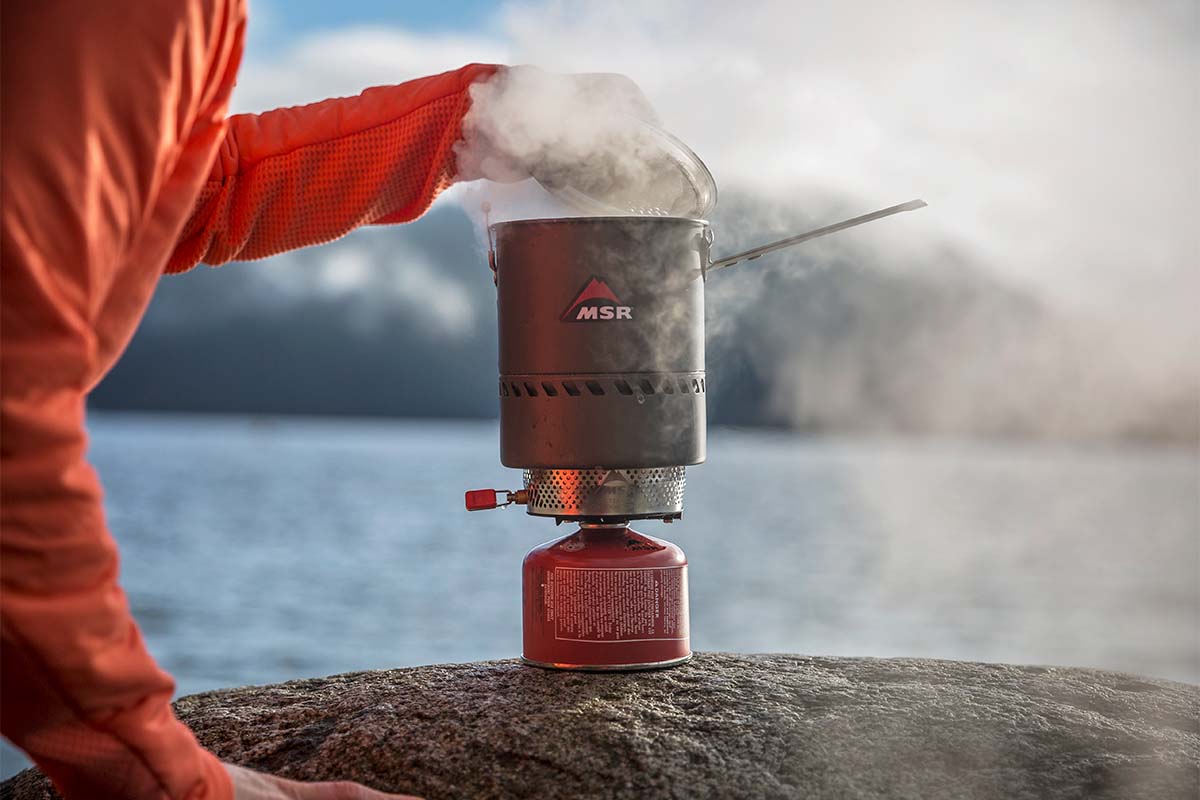
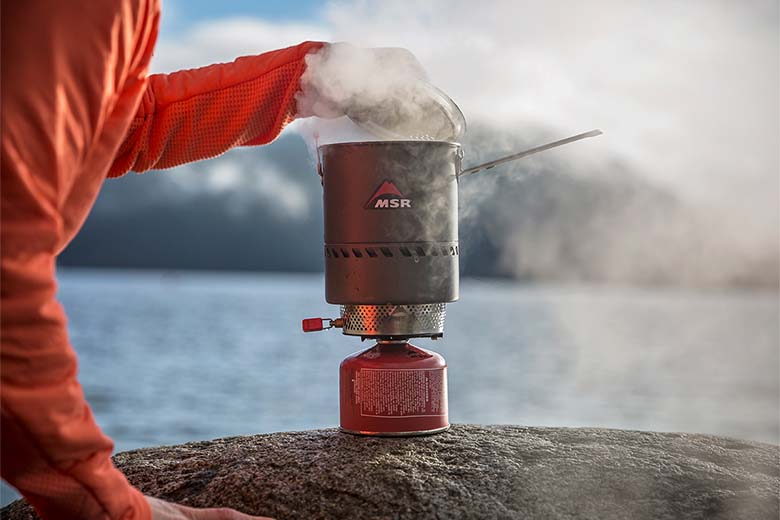
Backpackers need a stove that's lightweight, dependable, and will get the job done quickly after a long day on the trail. Thankfully, the market is full of both time-tested models and newer, more innovative designs. From all-in-one stoves made exclusively for boiling water fast to those that cook gourmet meals in the most alpine of conditions, there’s a stove to match every need. Below we break down the top backpacking stoves of 2025, including leading canister, liquid gas, alcohol, and wood-burning models. For more background information, see our comparison table and buying advice below the picks, along with details about our testing process.
Editor's note: We updated this guide on April 18, 2025, to name MSR’s Reactor 1.7L stove our top pick for melting snow, after it was cleared for use following a recall (originally issued due to a problem with the pot’s handle). We also revised information about the Jetboil Flash to reflect recent updates and added MSR’s new Switch Stove System after testing it on a backpacking trip in Wyoming’s Wind River range. Finally, we reviewed the entire guide for accuracy and refreshed the imagery with photos from recent field testing.
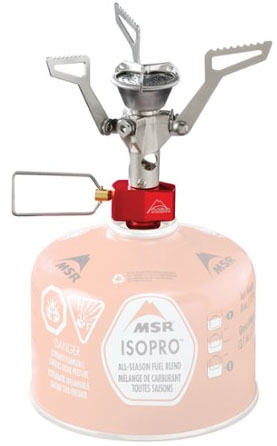 Fuel type: Canister
Fuel type: Canister
Weight: 2.6 oz.
Pot included?: No
What we like: Lightweight, inexpensive, and a surprisingly strong burner.
What we don’t: Integrated systems like the Jetboil Flash below are more stable and windproof.
MSR’s tiny PocketRocket 2 has achieved legendary status in the backpacking community, and for good reason: The streamlined screw-on stove allows for nice simmer control, weighs just 2.6 ounces and takes up very little space, and features a decently powerful burner for its size (8,200 BTUs). Tack on a price tag of just $50, and it's no wonder it's one of the most popular options on the market and a familiar sight in the backcountry. Integrated designs like the Jetboil Flash below offer better wind resistance, are more efficient, and come with a pot, but it speaks volumes that we still find ourselves reaching for the PocketRocket 2 on almost every backpacking trip.
Among the larger backpacking stove market, the PocketRocket 2 hits a highly desirable middle ground: While all-in-one designs like the aforementioned Flash excel at boiling water, they’re considerably heavier, bulkier, and more expensive. At the other end of the spectrum, true ounce-counters might be drawn to a minimalist system like an alcohol stove, but that comes with big compromises in terms of boil time, simmer control, and overall reliability. All in all, the PocketRocket 2 is everything most backpackers need and nothing they don’t, which is why it takes our top spot for 2025. And for a slightly more souped-up version, MSR also offers the $85 PocketRocket Deluxe, which weighs more at 2.9 ounces but includes a push-start igniter and regulator for better performance in the cold.
Read more: MSR PocketRocket 2 review
See the MSR PocketRocket 2

 Fuel type: Canister
Fuel type: Canister
Weight: 13.1 oz.
Pot included?: Yes (integrated)
What we like: Super fast boil time and great price.
What we don’t: Only excels at boiling water.
With the increased quality and selection of dehydrated meals, many backpackers now use their stove primarily to boil water. If this sounds like you, an integrated canister system like the Jetboil Flash is an excellent option. This all-in-one stove offers fast boiling with an included insulated cozy that attaches directly to the stove via a heat exchanger, making it efficient and wind-resistant (a key point of distinction between the Flash and non-integrated PocketRocket above). The Flash can boil one liter of water in around 4 minutes, and considering that you don’t need an additional pot, the total weight of 13.1 ounces is fairly reasonable. Plus, Jetboil recently gave the Flash some notable updates—including a turn-and-click ignition (similar to that on a home stove), a rubber grip along the base of the stove, and improved pot-to-stove locking points with helpful visual indicators—without increasing the price.
What are the shortcomings of the Jetboil Flash? And as we touched on above, it certainly isn’t ultralight by thru-hiking standards. The inclusion of a pot does help narrow the gap, although the PocketRocket 2 above with MSR’s Titan Kettle still checks in at 6.8 ounces, which is around half the weight of the Flash. And in tough conditions, the burlier MSR’s WindBurner below offers better performance in the wind (for a notable $70 and 2.2 oz. more). Last but not least, Jetboil’s own MiniMo below includes simmer control, but that model boils slower and costs more. All told, it’s tough to beat the boiling speed, price, and ease of use of the Flash, and we think it’s especially enticing for newer backpackers who prioritize convenience over weight.
See the Jetboil Flash Cooking System

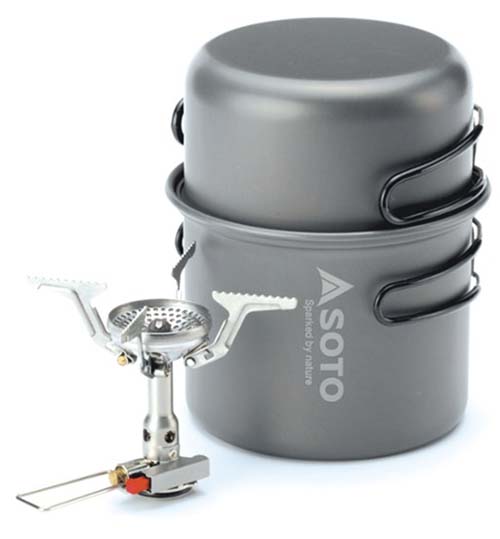 Fuel type: Canister
Fuel type: Canister
Weight: 11.2 oz. (stove only: 2.9 oz.)
Pot included?: Yes (2)
What we like: A great starter kit for a competitive price.
What we don’t: Not particularly lightweight and cookset isn’t very high quality.
If you’re starting from scratch and looking for a lightweight, affordable setup, it’s hard to go wrong with the Soto Amicus Stove and Cookset. For the same price as the MSR PocketRocket 2 above, you get a comparable stove and two pots, which is a true steal. And the Soto isn’t far behind the MSR in terms of specs: The PocketRocket 2 wins out in weight (0.3 oz. lighter), while the Amicus features a more compact size, comes with a built-in ignitor, and packs a serious punch with 10,200 BTUs (the PocketRocket is 8,200). Added up, it’s a great all-around deal and a solid setup for new and budget-minded backpackers alike.
The Soto’s 500- and 1,000-milliliter aluminum pots are nice for boiling water and cooking for up to two people, and the smaller pot can pull double duty as a lid and personal mug, as well. But while 11.2 ounces for two pots and a stove isn’t heavy per se, the pots themselves aren’t particularly high-quality, and you can shave a lot of weight by opting for a titanium cookset. If you want to stick with an all-in-one kit, it’s also worth checking out the PocketRocket 2 Mini Stove Kit ($105), but the Soto is the clear value winner. Finally, keep in mind that you can also purchase the Amicus stove on its own for $50 (or $45 without the ignitor), but for the same price, we’ll gladly take the included pots.
See the Soto Amicus Stove Cookset Combo

 Fuel type: Canister
Fuel type: Canister
Weight: 1 lb. 1.0 oz.
Pot included?: Yes (integrated)
What we like: Powerful burner and large pot are great for melting snow.
What we don’t: Expensive, heavy, and doesn't simmer.
The MSR Reactor is the most expensive model on our list by a wide margin, but you won’t find a better stove for boiling water or melting snow in alpine conditions. The protective housing, efficient and powerful burner (9,000 BTUs), and stable design make it one of the best stoves we’ve tested for cooking in mountainous areas like Peru, Nepal, and deep in the North Cascades. In fact, on a backpacking trip in Patagonia, the Reactor boiled water about four times as quickly as the Jetboil Stash and was significantly more effective in high winds. And while it’s far from ultralight at 1 pound 1 ounce (or 14.9 oz. for the 1L model), the MSR is still competitive among all-in-one systems like the Flash above (13.1 oz.) and MiniMo below (14.6 oz.).
There’s no denying the Reactor’s dominance, but not everyone will need to spend up for such a powerful design. At $290, it’s significantly more expensive than top performers like the Jetboil Flash ($130) and MiniMo ($170), and unlike many stoves here (including the MiniMo), it cannot simmer. Further, unless you’re in particularly challenging conditions or need the larger pot for melting snow, the 7,000-BTU Windburner below will be the more fuel-efficient option. And finally, liquid-gas stoves (like the WhisperLite below) are undeniably more reliable at elevation and in the cold, although—we get it—it’s hard to deny the convenience of a canister design (and we’ve had good luck using MSR’s Hanging Kit to keep the canister from freezing in the snow). All told, for alpinists, mountaineers, and high-altitude trekkers, the Reactor is head and shoulders above the rest. Note: The latest 1.7L and 1L pots feature slightly redesigned handles with reinforced connection points following a 2024 recall prompted by handle failures.
See the MSR Reactor 1.7L Stove System
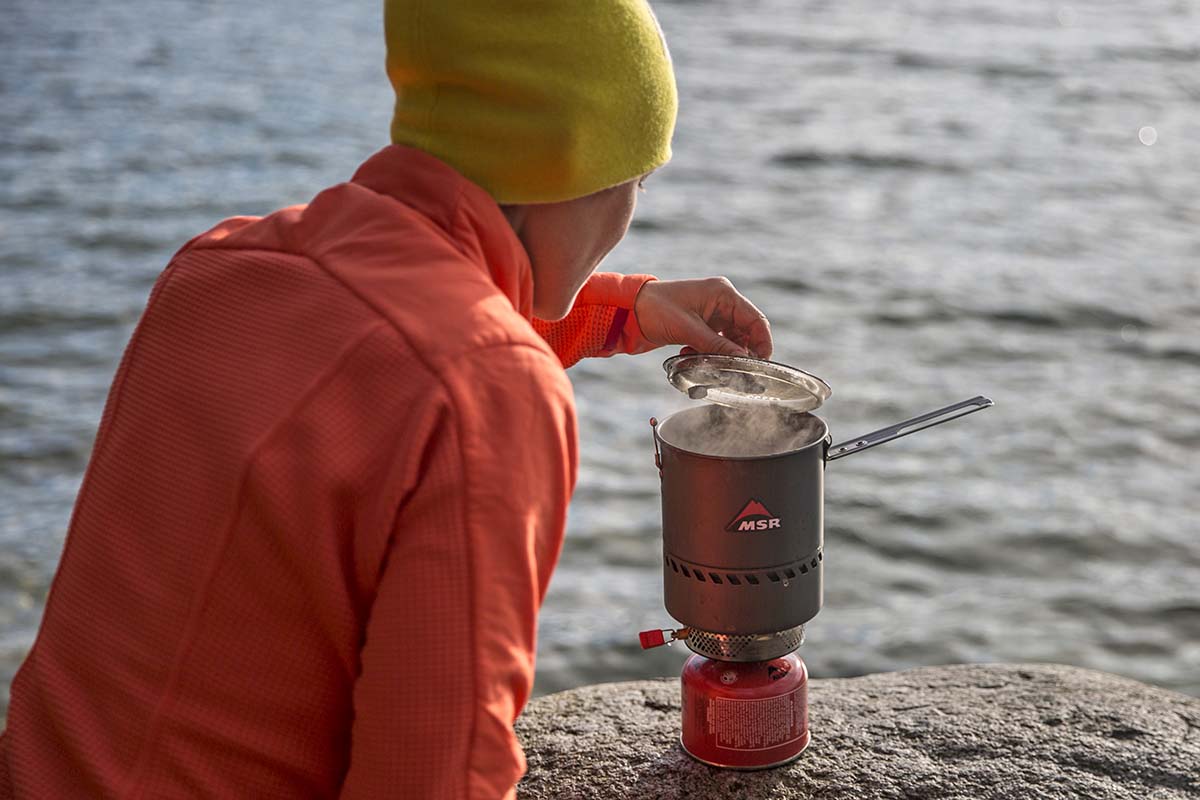
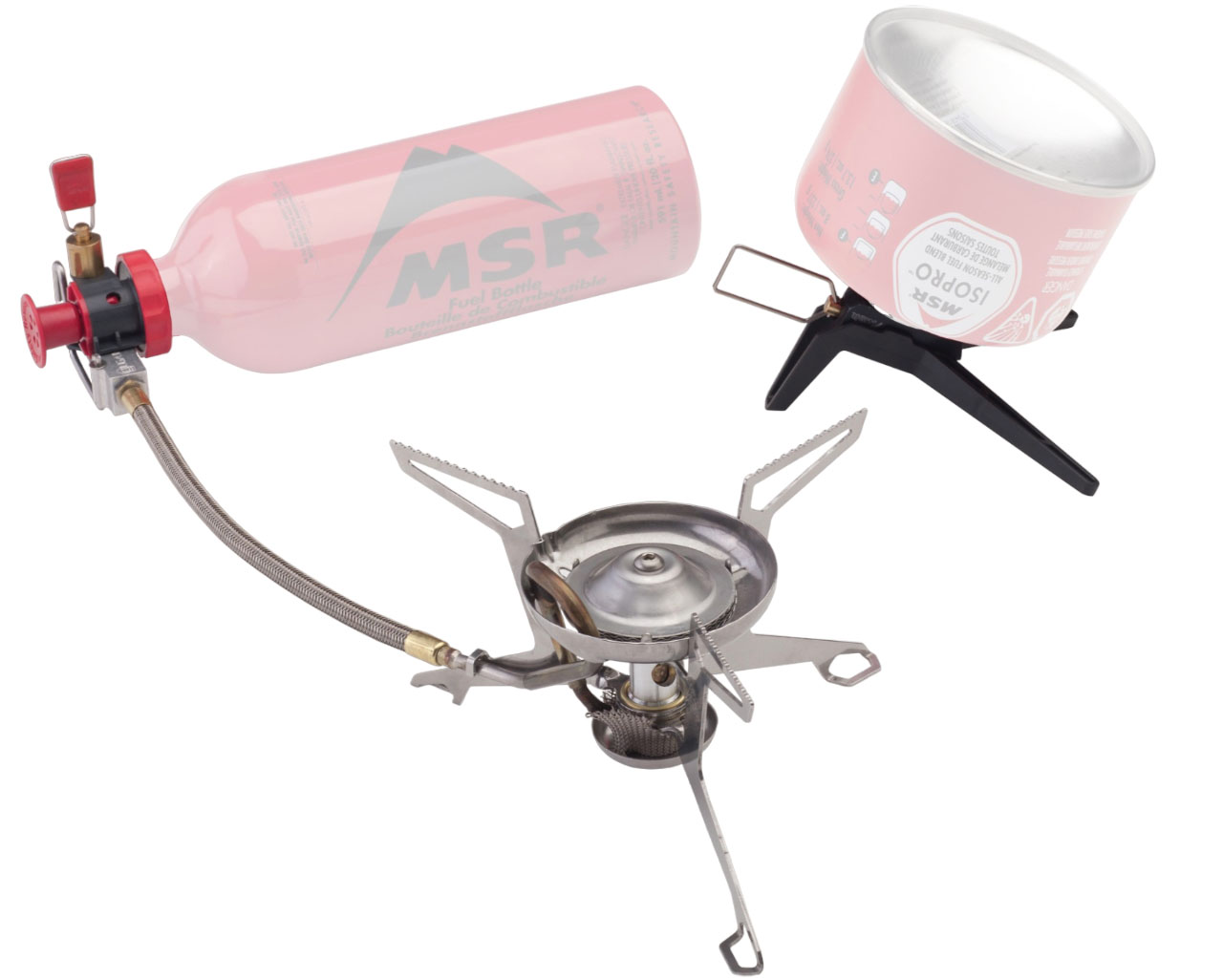 Fuel type: Canister/liquid
Fuel type: Canister/liquid
Weight: 11.2 oz.
Pot included?: No
What we like: Multi-fuel compatibility and an invertible canister.
What we don’t: Expensive and a bit heavy.
There are many factors that affect the function and efficiency of a backpacking stove, and cold weather is one of the biggest culprits. No style suffers more than a standard canister stove: These designs depressurize in sub-freezing temperatures, which impedes the movement of the fuel to the stove. The best solution for cold-weather campers is a liquid-fuel stove (the integrated pump allows you to regulate the pressure) or a stove with a remote canister that can be inverted. Within this category, our favorite model is the MSR WhisperLite Universal, a time-tested workhorse that has the ability to operate off of both liquid fuel and a remote (read: invertible) canister.
The WhisperLite Universal doesn’t come cheap, but it is the most versatile option here. In mild temperatures, you get a canister stove with excellent flame control in an easy-to-use package. Conditions colder than expected? Simply invert the canister. And in truly frigid weather, liquid fuel is far and away the most reliable choice. Further, with multi-fuel capability (you can put everything from white gas to kerosene or unleaded gasoline in the fuel bottle), the Universal is also our top pick for international travel, when canisters and white gas can be hard to come by. The cherry on top: It’s durable, easy to clean and repair, and decently lightweight. And for a step down in price, you can also opt for the WhisperLite International ($160), which is compatible with a variety of liquid fuel (but not canisters).
See the MSR WhisperLite Universal
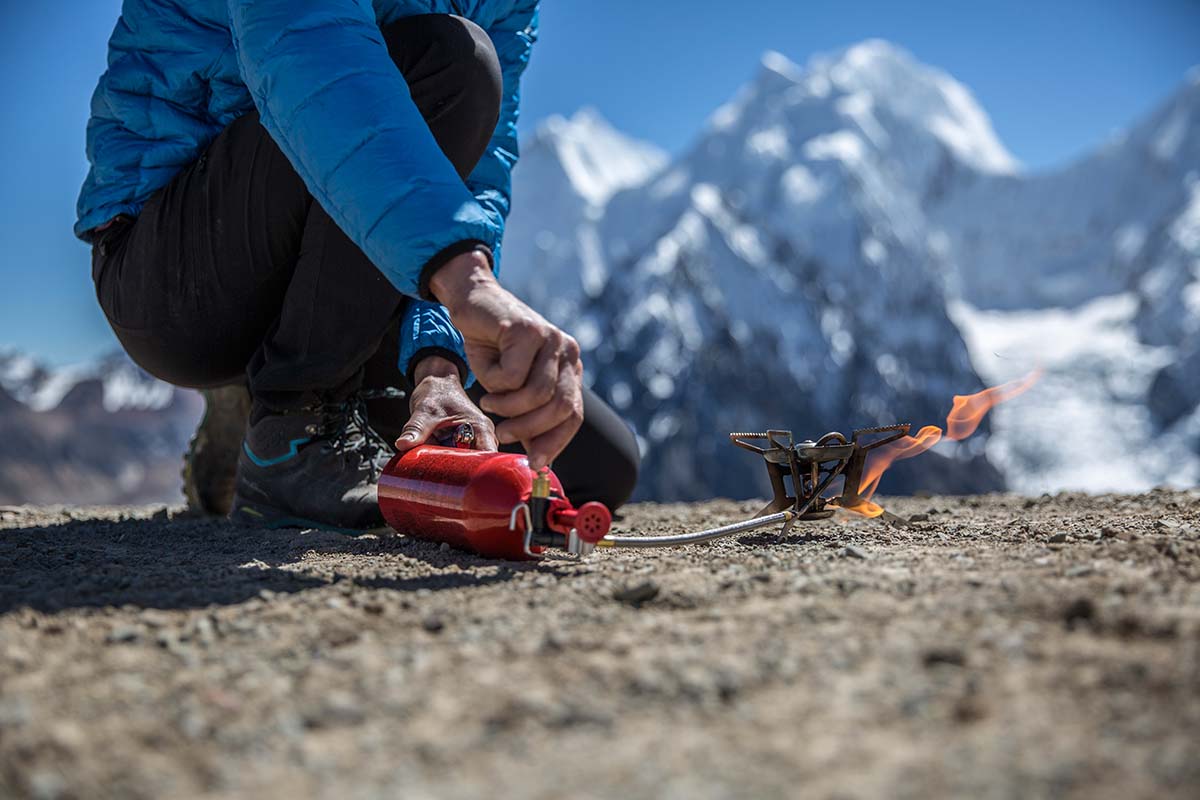
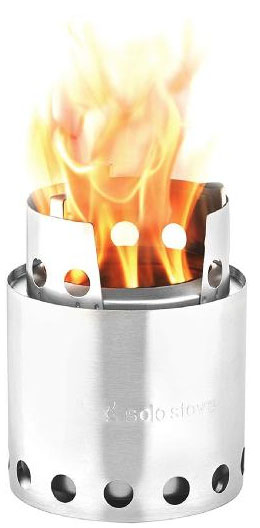 Fuel type: Wood
Fuel type: Wood
Weight: 9.0 oz.
Pot included?: No
What we like: Simple, efficient, and can double as a windscreen for an alcohol stove.
What we don’t: Some wilderness areas do not permit wood stoves.
Alternative-fuel stoves have their appeals for thru-hikers or fastpackers looking to keep their pack weight low. By opting for a wood, alcohol, or tablet-burning design (we detail these categories in our buying advice below), you can ditch the heavy and bulky gas canisters used by most stoves here, bringing along smaller containers of fuel or foraging for biomass (wood, pinecones, etc.) instead. The Solo Stove Lite is our favorite alternative-fuel option of the year, with a versatile design that burns wood and also functions as a windscreen/pot support for an alcohol stove (a nice backup to have when you’re venturing above treeline). And with a double-wall construction that recirculates hot air, feeds oxygen directly to the embers, and focuses the flame through a small opening at the top, the Solo beats out most wood-burning stoves in terms of boil times and efficiency.
The Solo Stove Lite is great for hikers who are curious about ultralight gear, but there’s no denying that it’s neither the lightest nor the most packable stove solution. If “8-pound base weight” is part of your vocabulary, chances are you’ll be reaching instead for models like the Solo Alcohol Burner or Esbit Pocket Stove below. Of course, alternative-fuel designs can’t hold a candle to liquid or canister stoves in terms of power and boil time, but if you enjoy being leisurely in camp, this shouldn’t be an issue. Finally, keep in mind that wood-burning stoves are often banned in fragile wilderness areas or regions prone to wildfires. But for those wanting something a little different, Solo’s Stove Light is a nice introduction to alternative-fuel stoves, and it doesn’t hurt that it’s very simple and easy to maintain.
See the Solo Stove Lite
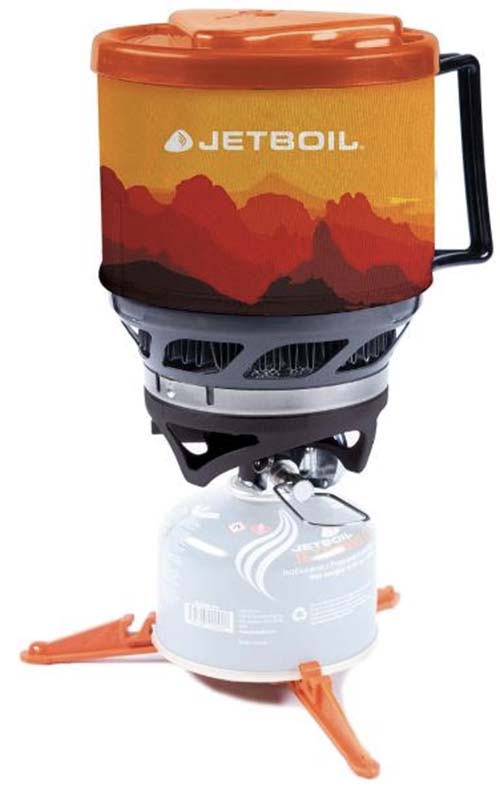 Fuel type: Canister
Fuel type: Canister
Weight: 14.6 oz.
Pot included?: Yes (integrated)
What we like: Impressive simmer control for cooking over the flame.
What we don't: Expensive and slower boil time than the Flash above.
Jetboil has become synonymous with all-in-one systems that boil water fast, but the MiniMo has some additional tricks up its sleeve. With an upgraded temperature regulator for impressive simmer control, the MiniMo offers the convenience of the Flash above but with better cooking functionality that many backcountry travelers seek. In terms of features, the 1-liter cooking pot is wrapped in a neoprene sleeve for safe handling, and its short and stout build offers stability over the flame and doubles as a bowl when your meal is ready to eat. If you like to cook and not just boil water, the MiniMo is a great option.
At $170, the MiniMo costs significantly more than the Flash, boils water more slowly (4 min. 30 sec. per liter vs. the Flash’s 3 min. 20 sec.), and weighs about an ounce more. That said, the trade-offs are well worth it for those who cook their own meals and want the added simmer control. You can also opt for a non-integrated system—for example, pair the MSR PocketRocket 2 above with a cook pot—but the MiniMo is undeniably more premium, and we love the added wind resistance and stability you get from the all-in-one design. Added up, it’s our top choice for one to two campers looking for an integrated system with simmer control.
See the Jetboil MiniMo Cooking System
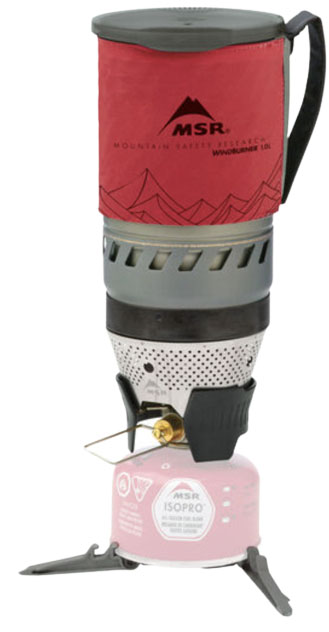 Fuel type: Canister
Fuel type: Canister
Weight: 15.3 oz.
Pot included?: Yes (integrated)
What we like: Excellent windy-weather performance for less than the Reactor above.
What we don't: No built-in igniter and not as powerful as the Jetboil Flash.
Similar to the Jetboil Flash above, the MSR WindBurner is a great integrated stove solution if your backcountry cooking routine consists mostly of boiling water. We love the windproof design: After lighting the stove and snapping everything into place, the enclosed burner brings water to a boil quickly, even in gusty conditions (this can be a weakness of Jetboil models, which leave more of the stove exposed). In terms of quality, practically everything about this stove—from the honeycomb burner to the lid—is well made and has stood up over time. The price of the WindBurner is steep at $200, but it’s a top-notch backpacking stove overall.
So why is the MSR WindBurner ranked here? The added weather protection is overkill for many summer backpackers, and in our opinion is not worth the $70 increase in price from the Jetboil Flash. Furthermore, the WindBurner takes longer to boil a liter of water than the Flash (it puts out 7,000 BTUs vs. the Jetboil’s 9,000) and does not include a convenient built-in ignitor. But for those traveling to windy regions and expecting a lot of exposure, it’s a premium all-in-one stove that will cost you a significant $120 less than the Reactor above (we also prefer the security of the Windburner’s all-in-one design for precarious situations like portaledges and cramped bivys). Finally, the WindBurner line also includes the Duo and Combo stove systems, which feature larger pots, remote canister attachments (for better cold-weather performance), and the ability to simmer.
See the MSR WindBurner Stove System
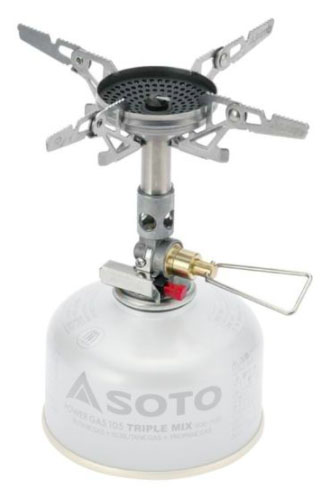 Fuel type: Canister
Fuel type: Canister
Weight: 3.0 oz.
Pot included?: No
What we like: More wind-resistant and efficient than the PocketRocket 2 above.
What we don’t: Heavier and pricier than the MSR.
As we mentioned above, non-integrated canister stoves like the MSR PocketRocket leave more of the flame exposed, which can impact performance in gusty conditions. To help combat this, Soto came up with an interesting solution in their aptly named WindMaster. The key difference lies in the pot support design: Compared to the one-piece MSR, the Soto’s clamp-on arms don’t extend as far upward, allowing the pot to sit closer to the flame. Further, the burner has a concave shape that helps protect it better against strong winds. The Jetboil Flash and MSR WindBurner above still offer improved coverage with their integrated designs, but the WindMaster is considerably cheaper, and many backpackers have reported years of reliability in harsh conditions.
Apart from the improved wind protection, the WindMaster is heavier than the PocketRocket 2 by around half an ounce and costs $20 more. However, the Soto has a built-in igniter and offers a more stable, four-prong base for larger pots (ounce-counters can swap in the lighter-weight TriFlex pot support for around $10 to $15 extra). All in all, you can definitely go lighter and cheaper in this category, but the WindMaster strikes us a nice middle ground between the PocketRocket and bulky/expensive WindBurner above. If you consistently backpack at altitude or in places notorious for wind (Colorado’s Fourteeners, for instance) but still want a system that’s small and compact, the Soto is an excellent pick.
See the Soto WindMaster Stove
 Fuel type: Canister
Fuel type: Canister
Weight: 13.8 oz. (stove only: 4.1 oz.)
Pot included?: Yes
What we like: A versatile stove for backcountry chefs; everything nests nicely inside the included pot.
What we don’t: Master of none; lands oddly in between the PocketRocket and Jetboil Flash.
New for 2025, MSR’s Switch Stove aims to provide a more versatile backcountry cooking experience with its interchangeable stove system. The included 1-liter pot sits nicely on the stove’s ring stand, ideal for boiling water for dehydrated meals or morning coffee, but if you want to kick your culinary experience up a notch, three supports can be flipped out to support a backpacking skillet for cooking pancakes or real-food dinners. What’s more, the stove includes a piezo ignition for easy lighting and a pressure regulator for flame control and precise cooking. The pot has a few bells and whistles too, including a burn-resistant cork grip, strainer lid, and dome-shaped bottom for more efficient heat transfer. And when you’re ready to hit the trail in the morning, the whole system—stove, canister, pot supports, and plastic bowl—nest inside the pot (the plastic bowl attaches to the bottom of the pot).
The Switch Stove sits somewhere between a minimalist option like MSR’s PocketRocket and an all-in-one system like the Jetboil Flash. In comparison, however, the Switch Stove has a few downsides. At 4.1 ounces, the stove is heavier than the 2.6-ounce PocketRocket, and the system doesn’t feel fully integrated—the pot rests on the ring support rather than screwing into the burner like the Jetboil, making it less stable overall. And despite the pot’s hemispherical design, the Jetboil consistently boiled water faster than the Switch in side-by-side testing. Still, the Switch stands out for its flexibility: It’s a unique concept that delivers well in its first iteration. And for backcountry cooks willing to carry a little extra weight, the added functionality is a worthwhile trade.
See the MSR Switch Stove System
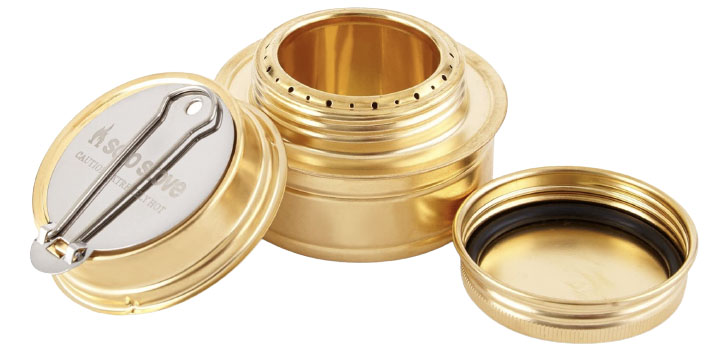 Fuel type: Denatured alcohol
Fuel type: Denatured alcohol
Weight: 3.5 oz.
Pot included?: No
What we like: A standout alcohol stove with a thoughtful design.
What we don’t: You’ll have to buy a pot stand and windscreen separately.
In the world of ultralight backpacking, alcohol stoves have gained traction as the ultimate minimalist cooking system, thanks to their low-profile build and the ubiquity of denatured alcohol (which can be found at most hardware stores, gas stations, and grocery stores). The Solo Alcohol Burner stays true to the simple tin-can design but with some modern and convenient features added to the mix. With a durable brass construction and flame regulator, the stove is tough, burns efficiently, and provides more temperature control than other alcohol-burning designs. Moreover, a screw-on lid with rubber gasket allows you to store excess fuel in the stove rather than pouring it back into your container (and inevitably wasting a few drops in the process). Whether you’re an ounce-counting thru-hiker or looking for a solid backup stove, the Solo Alcohol Burner is worth a closer look.
Of course, you’ll need to pair your alcohol stove with a windscreen and pot stand, which could be as simple as a piece of foil and a pile of rocks or as refined as the Solo Stove Lite above, which integrates well with the Solo Alcohol Burner here. Keep in mind that alcohol stoves are decidedly slower than the standard canister and liquid fuel options—it might take upwards of 10 minutes to boil a liter of water. Finally, while the Solo is arguably the go-to alcohol burner for thru-hikers, you can go even lighter with a stove like AntiGravityGear’s Tin Man (made from a recycled soda can), which clocks in at just 0.4 ounces. But the Solo is a better balance of weight and features, and we appreciate its user-friendly and refined build. Finally, remember to do your research before you go, as some wilderness areas have banned alcohol stoves.
See the Solo Stove Alcohol Burner
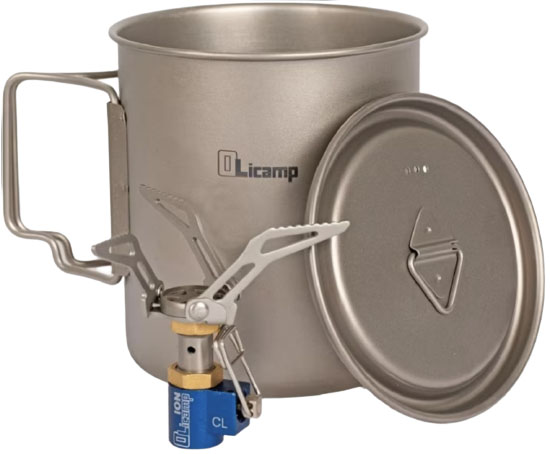 Fuel type: Canister
Fuel type: Canister
Weight: 5.5 oz. (stove only: 1.5 oz.)
Pot included?: Yes
What we like: Very lightweight and packable; high-quality titanium components.
What we don’t: There are limitations to having your pot double as your mug.
The Soto Amicus Stove Cookset Combo above is a great starter kit for penny pinchers, but you can step up your ultralight game with the OliCamp Ion Stove/Titanium Space Saver Mug Combo here. For just 5.5 ounces all in, you get a titanium stove (ridiculously lightweight at just 1.5 oz.) and a 750-milliliter titanium mug (and lid) that’s shaped to fit around a 1-liter Nalgene or 3.9-ounce propane/isobutane canister. The result is a durable and refined stove system for one that will take up very little space in your pack, making it an ideal choice for UL backpacking, fastpacking, and other weight- and space-conscious activities.
That said, OliCamp’s ultralight combo does have some limitations. For one, its 4-minute-20-second boil time is not particularly fast, and that’s in ideal conditions (we recommend picking up a lightweight windshield to boost efficiency). Second, the 750-milliliter (3/4L) mug isn’t a great fit for two campers, especially if you’re using it as your drinking/eating vessel as well. And finally, if you are using the titanium mug to both heat water and drink, you’ll need to be really careful not to burn your hands and lips. There are always compromises to ultralight gear, but the OliCamp Ion stove and mug combo is nevertheless a big step up in quality from the Soto Amicus above.
See the OliCamp Ion Stove with Titanium Mug Combo
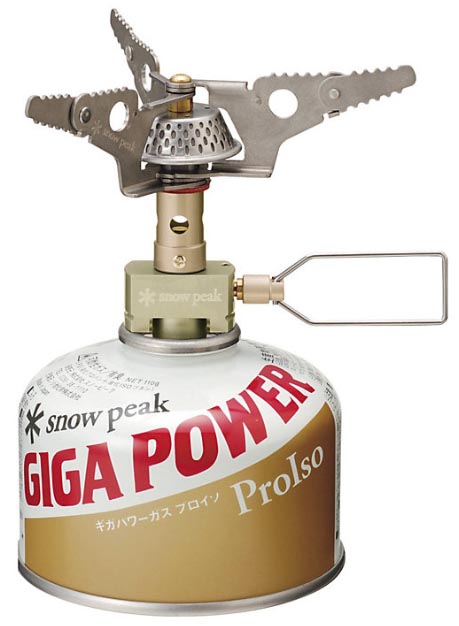 Fuel type: Canister
Fuel type: Canister
Weight: 1.9 oz.
Pot included?: No
What we like: Very light and well-made.
What we don’t: Price jump for minimal weight savings.
For ULers who scoff at the “heavy” MSR PocketRocket 2 and Soto WindMaster and Amicus above, the Snow Peak LiteMax is a similar screw-on design but with higher-end and lighter-weight materials. A mix of titanium and aluminum reduces the total weight to an impressive just under 2 ounces, making the LiteMax one of the lightest canister stoves on the market. You also get great flame adjustability and support arms that offer a pretty wide base, and the LiteMax burns hot for a stove of this type.
What are the downsides of the LiteMax? Japan-based Snow Peak is known for their quality craftsmanship, and the LiteMax is beautifully made, but it’s also an extremely slow boiler. We took one on a summer backpacking trip in the North Cascades and could literally boil multiple pots of water with our MSR WindBurner is less time than it took one pot to boil with the LiteMax. Further, stability is compromised by the ultralight design. The MSR PocketRocket 2 isn’t a standout in stability or boil time either, but it still beats out the LiteMax in both categories. Snow Peak also makes the popular GigaPower 2.0, which is over 2 ounces heavier than the LiteMax but includes four prongs (one more than the LiteMax) for added stability and an integrated igniter.
See the Snow Peak LiteMax
 Fuel type: Canister
Fuel type: Canister
Weight: 6.6 oz.
Pot included?: No
What we like: 4-season capabilities at a low weight and price.
What we don’t: Not multi-fuel compatible like the MSR WhisperLite above.
As we mentioned above, remote canister stoves allow you to invert your fuel canister in cold weather, which helps maximize performance when the mercury dips. They’re also generally easier to protect in the wind (a windscreen can completely encase the stove) and sit close to the ground, resulting in added stability for larger pots and pans. In this category, OliCamp makes an intriguing design in their Generator. For just $60, you get 4-season versatility in an impressively light and packable design (the support legs are foldable for easy and compact storage), as well as good output and flame control. All in all, it’s a well-made and thoughtfully designed stove at a very reasonable price.
One key difference separates the OliCamp Generator from the MSR WhisperLite Universal above: multi-fuel compatibility. While the MSR can run on liquid fuel like white gas, auto fuel, or diesel, the Spider only works with propane/isobutane canisters, which tend to suffer at high altitudes and in extreme cold (and if you’re traveling internationally, remember that they aren’t always readily available). In the end, the WhisperLite Universal above is the most versatile of the bunch and our preferred remote canister design, but the OliCamp is nearly 5 ounces lighter and will save you a considerable $140. If you don’t anticipate needing to use other types of fuel, that’s a no-brainer.
See the OliCamp Generator Remote Stove
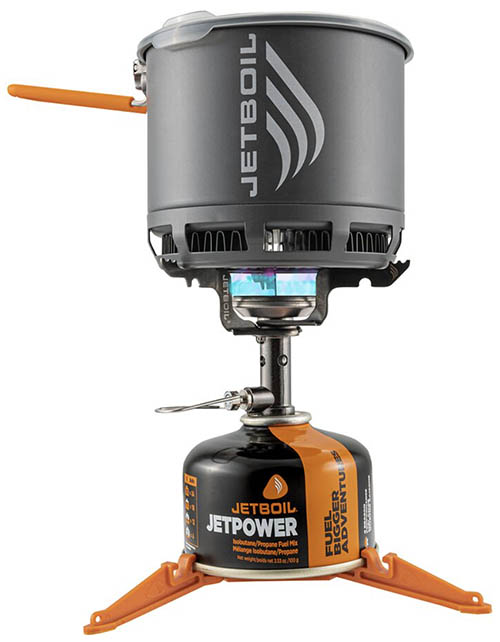 Fuel type: Canister
Fuel type: Canister
Weight: 7.1 oz. (stove only: 2.1 oz.)
Pot included?: Yes
What we like: Jetboil’s lightest and most compact offering yet.
What we don’t: Expensive, doesn’t simmer, and lacks Jetboil’s standard heat exchanger.
Jetboil’s Stash is their lightest stove system yet. At just 7.1 ounces all in for the canister stove (2.1 oz.) and 0.8-liter aluminum pot (5 oz.), it’s a whopping 40% lighter than the next-in-line Zip. And with a nesting design, you can fit the stove, stand, and a 100-gram fuel canister into the pot for a nice, compact package. Unlike most Jetboil systems, the Stash does not have a heat exchanger on the stove side (read: less efficiency and wind resistance compared to integrated designs), but the pot’s FluxRing is a nice compromise and keeps the boil time decently fast (2.5 min. for 0.5L).
However, we run into some roadblocks when asking, “Who should buy the Stash?” Sure, it’s a nice combo set for those starting from scratch, but at $150, it’s triple the cost of the Amicus Stove Cookset Combo above (and unlike the Amicus, the Stash doesn’t simmer). Further, true ounce counters can go lighter by pairing a simple stove like the Snow Peak Lite Max (1.9 oz.) or Soto WindMaster (3 oz.) with a titanium pot. Finally, the Stash’s output doesn’t quite live up to Jetboil’s reputation with only 4,500 BTUs (compared to the Flash’s 9,500)—on a recent backpacking trip in Patagonia, our friends’ MSR Reactor boiled water about four times as fast. We’re admittedly being hard on the Stash but nevertheless recommend saving your cash and sticking with some of the options higher on the list.
See the Jetboil Stash Cooking System
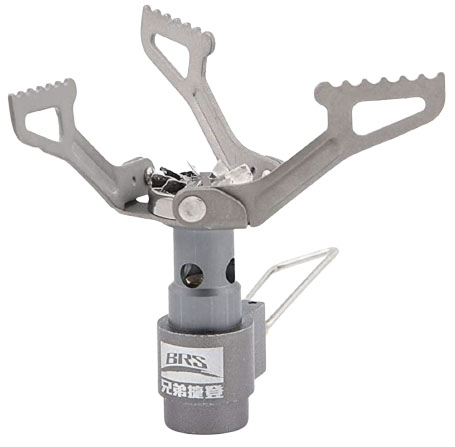 Fuel type: Canister
Fuel type: Canister
Weight: 0.9 oz.
Pot included?: No
What we like: Really, really cheap and still works.
What we don’t: Inferior performance compared to the PocketRocket and similar models above.
At a double-take-worthy price of $18, the BRS 3000T doesn’t inspire a lot of confidence, but its performance stacks up surprisingly well to standalone stoves from MSR, Snow Peak, Soto, and others. The generic design—we’ve seen very similar models under the name Icetek Sports—doesn’t try to reinvent the wheel, but it does offer decent flame control and performance for casual backpackers. The stove functions in a similar way to the MSR PocketRocket above, running on isobutane/propane canisters, and includes folding pot supports and an easy-to-use control valve (note: You don’t get push-button ignition).
At such a low cost, there are a few letdowns in the build. For one, the stove doesn’t burn nearly as efficiently as the PocketRocket, WindMaster, or LiteMax, so you will go through a fuel canister in a shorter amount of time (this can add up, particularly on longer trips.) Moreover, the stove doesn’t do well in the wind and will take longer to boil at full power, and it’s noticeably flimsier and less durable than the pricier canister options on our list. But if you set reasonable expectations, the BRS 3000T nevertheless is an intriguing budget option with a solid track record.
See the BRS 3000T
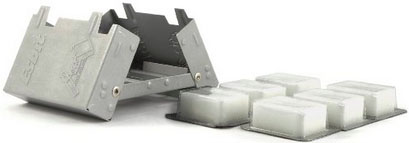 Fuel type: Tablets
Fuel type: Tablets
Weight: 3.3 oz.
Pot included?: No
What we like: Cheap and ultralight.
What we don’t: Cooks slowly, messy and stinky, and no flame control.
For those going ultralight and who don’t use their stove often, the Esbit is a true test of your minimalist loyalties. Powered by solid fuel tablets, this system is lightweight and bucks the need for canister or liquid fuel systems altogether. Its best uses are as a backup or emergency stove, not a primary stove, and some people even use the Esbit for day hiking to heat up beverages and small meals. For the weight and price, it’s a pretty decent option for these purposes.
Each fuel tablet weighs 0.5 ounces and offers about 12 minutes of burn time, but cooking is much less efficient than canister or liquid-fuel systems, and you have little control over the intensity. You also may find a sticky residue on the bottom of pots and pans from burned-up tablets. As a final note, there may be restrictions on using Esbit or alcohol stoves in U.S. national parks—especially during burn bans—due to the potential fire danger (see our buying considerations below for more information). But if you're curious about alternative fuels, solid tablets are certainly fun to try. And for a package deal, check out the Esbit Solid Fuel Stove and Cookset and Toaks Ultralight Titanium Solid Fuel System, both of which include a pot and windscreen.
See the Esbit Pocket Stove
| Stove | Price | Fuel Type | Weight | Pot Included? | Auto Ignition? | Boil Time |
|---|---|---|---|---|---|---|
| MSR PocketRocket 2 | $50 | Canister | 2.6 oz. | No | No | 3.5 min (1L) |
| Jetboil Flash Cooking System | $130 | Canister | 13.1 oz. | Yes (integrated) | Yes | 2 min (.5L) |
| Soto Amicus Stove Cookset | $50 | Canister | 11.2 oz. | Yes | Yes | 4.4 min (1L) |
| MSR Reactor 1.7L System | $290 | Canister | 1 lb. 1.0 oz. | Yes (integrated) | No | 3 min (1L) |
| MSR WhisperLite Universal | $200 | Canister/liquid | 11.2 oz. | No | No | 3.5 min (1L) |
| Solo Stove Lite | $70 | Wood | 9.0 oz. | No | No | 8-10 min (1L) |
| Jetboil MiniMo System | $170 | Canister | 14.6 oz. | Yes (integrated) | Yes | 4.5 min (1L |
| MSR WindBurner System | $200 | Canister | 15.3 oz. | Yes (integrated) | No | 4.5 min (1L) |
| Soto WindMaster Stove | $70 | Canister | 3.0 oz. | No | Yes | 2.5 min (.5L) |
| MSR Switch Stove System | $140 | Canister | 13.8 oz. | Yes | Yes | 2.5 min (.5L) |
| Solo Stove Alcohol Burner | $20 | Alcohol | 3.5 oz. | No | No | 5-7 min (1L) |
| OliCamp Ion w/ Mug | $85 | Canister | 5.5 oz. | Yes | No | 4.3 min (1L) |
| Snow Peak LiteMax | $50 | Canister | 1.9 oz. | No | No | 4.4 min (1L) |
| OliCamp Generator Remote | $60 | Canister | 6.6 oz. | No | No | 3.6 min (1L) |
| Jetboil Stash System | $150 | Canister | 7.1 oz. | Yes | No | 2.5 min (.5L) |
| BRS 3000T | $18 | Canister | 0.9 oz. | No | No | Unavailable |
| Esbit Pocket Stove | $16 | Tablets | 3.3 oz. | No | No | 8 min (.5L) |
The Switchback Travel team has been testing and reviewing backpacking stoves since 2013—in fact, it was one of the first round-ups we ever published. Founder David Wilkinson can be credited with putting together our initial lineup of just five stoves, one of which was a DIY design improvised from a can of cat food. Former editor-in-chief John Ellings and former senior editor Jenny Abegg began contributing a few years later and worked to modernize the list based on their experiences throughout the Pacific Northwest and as far abroad as Patagonia, although some longtime favorites have stood the test of time (the MSR PocketRocket, for example, has been a staple on this list for over a decade). Editor Maddie Downie took over the guide in 2024. A fan of early-morning ski missions, Maddie loves enjoying a hot cup of coffee in her sleeping bag and is always happy to take over snow-melting duties to get one.
Our lineup of 17 stoves above covers the full gamut, from ultralight canister and alternative-fuel models for weight-conscious backpackers to liquid-fuel options for cold-weather pursuits. In choosing our favorites, we prioritized several different factors. Weight and bulk are important considerations for most (your backpack can only fit so much), although many new and recreational backpackers will likely be willing to shuttle a little more in the name of convenience. Boil time, burner output, and wind resistance are also worth taking into account, and remember that conditions can have a big impact on the efficiency of your stove. Each design had to stand out in one or more categories to be included above, and we’ll continue testing new and noteworthy designs on backpacking trips near and far to keep our list up-to-date.

Canister and Remote Canister Stoves
Canister stoves, which run on a mix of primarily isobutane and propane, dominate the backpacking market. What makes them so popular is the user-friendly design: Simply connect the fuel canister to the stove, light it, and you’re good to go. Further, the mixture burns very clean, can be set to either simmer or boil quickly (especially with an advanced design like the Jetboil MiniMo), and heats very efficiently. Canister stove models vary widely, ranging from small and light (MSR’s PocketRocket 2) to all-in-one systems that boil water efficiently (Jetboil’s Flash). You also have remote canister designs like the MSR WhisperLite Universal and OliCamp Generator Remote Stove, which sit directly on the ground and feature a hose that connects to the canister remotely and allows you to invert it for better performance in the cold.
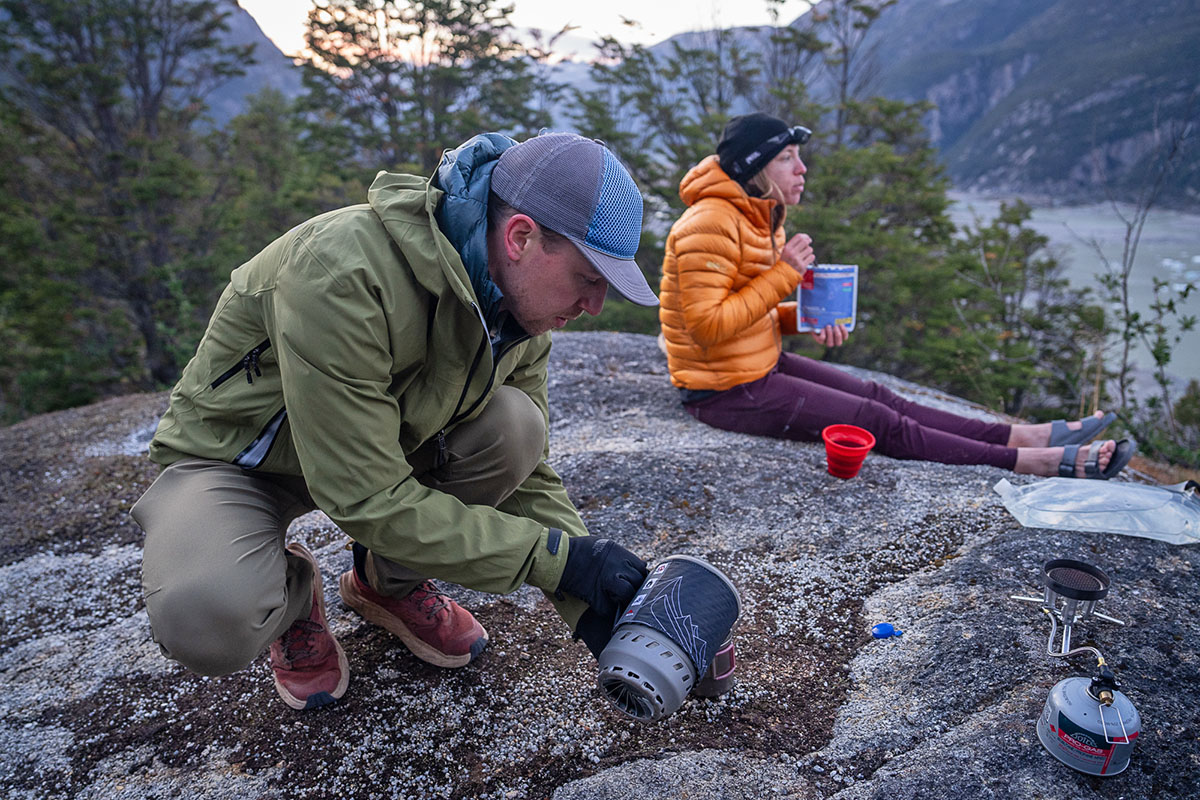
But canister stoves do have their downsides. For one, they often suffer in cold weather, especially when compared to white gas models. Remote canister designs are a step up, but liquid gas is far and away the most reliable option. Second, the metal canister itself is fairly heavy and bulky, which can become an issue if you need to carry a lot of fuel for extended backcountry travel. If you’re cooking two meals a day for a week or two—not just boiling water, but cooking meals—a liquid-fuel stove is a better option. Third, isobutane/propane canisters don’t refill easily, which results in a great deal of waste. And finally, isobutane/propane canisters aren’t always easy to track down overseas, and you certainly can’t fly with them. For more, see our sections on used isobutane/propane canisters and traveling internationally below.
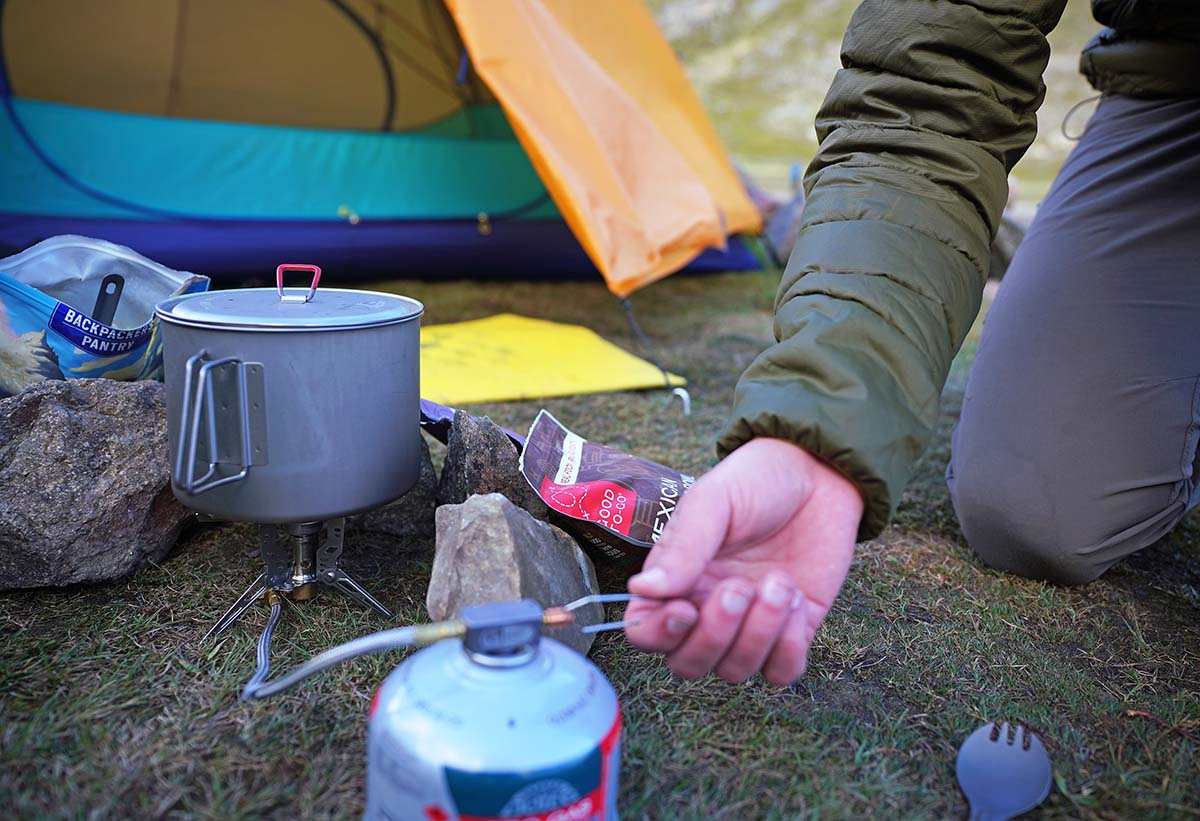
Liquid and Multi-Fuel Stoves
Stoves that are set up to run on liquid fuel, like the ubiquitous MSR WhisperLite, have a fuel line that connects to a separate refillable bottle. Most liquid-fuel stoves run on white gas, although there are a number of models that can use multiple fuel types, including kerosene and unleaded gas (the MSR WhisperLite Universal/International and XGK EX are a few examples). If you’re traveling overseas, these versatile designs are your best bet. Liquid gas (namely white gas) burns hotter than isobutane/propane, so the stoves offer better performance in cold weather and at altitude. Furthermore, white gas is a far better fuel choice for longer trips, as you can bring more with less bulk, and even store your backup supply in a lightweight plastic bottle (just don’t mistake it for water!). But perhaps our favorite thing about liquid fuel is the way that it cuts down on waste—you can purchase it in bulk and reuse the same fuel bottle over and over again.

For short trips, we still prefer stoves that run on isobutane/propane over liquid fuel models for their lightweight, compact builds and remarkable convenience. Liquid fuel stoves are slower to set up and use, and you’ll need to pump the bottle every few minutes to maintain pressure (especially when it’s less than full). These stoves are also usually bulkier, heavier, and more expensive than their canister alternatives. All in all, if your trips extend past the length of a week (without resupply), are outside of the United States, or venture into cold or high-altitude environments, we recommend a liquid fuel stove. For all other backpacking needs, a canister stove is still our cook setup of choice.
Alcohol Stoves
Stoves that run on denatured alcohol are popular among ultralight and thru-hiking communities, preferred for their affordable price, lightweight construction, and simplicity. The most basic design can be made by punching holes along the rim of a tuna fish or cut-off soda can, and more complex stoves offer features such as simmer control, an integrated windscreen, or a pot stand (like the Solo Stove Alcohol Burner and accessories). Alcohol stoves can’t compete with the liquid or canister stoves above in terms of efficiency, heat output, or flame control, but they do take the cake for simplicity and overall weight. And perhaps one of the biggest selling points of an alcohol stove is the ease of acquiring fuel, especially at hardware stores or gas stations in small resupply towns.
.jpg)
Wood-Burning Stoves
Epitomized by the Solo Stove Lite, wood-burning stoves use sticks, pinecones, leaves, and other dead and downed forest items for fuel, resulting in an extremely lightweight stove that doesn’t require you to pack any additional fuel weight or bulk. Logically, these stoves make a good option for those heading out for long-term sojourns in the woods—you can collect your fuel as you go. However, wood-burning stoves take a great deal of care, and don’t hold a candle to the ease of use or output of a more traditional canister or liquid-fuel stove. Because of this, we recommend them for backcountry travelers who enjoy the novelty of an actual fire and don’t mind a slower meal prep process. And take note: Wood is not a clean-burning fuel and will leave your stove and cookware covered in soot. You will also need to check for local fire and twig collection regulations before you use a wood-burning stove, and consider the fact that your potential fuel may be wet.
.jpg)
Solid Fuel Tablet Stoves
We include one tablet stove on our list: the Esbit Pocket Stove. This ultralight, fringe piece runs off of solid fuel tablets, and clocks in at just over 3 ounces. We wouldn’t want to cook or boil water consistently with such a stove—the small cubes don’t burn as hot as other fuel and are known to leave a sticky mess on the bottom of pots. But the Esbit—and other tablet stoves—is a great backup option to bring along just-in-case. And as with wood stoves, you’ll want to check on regulations before you use your tablet stove in the field; notably, Rocky Mountain National Park has banned alcohol and Esbit stoves because they lack a shutoff switch or valve.
Integrated Stoves
An integrated system like the Jetboil Flash is unique to canister stoves, and consists of a burner, heat exchanger, and pot that all secure to the top of a fuel canister in one streamlined package. The all-in-one setup has the clear advantage of efficient heating: When everything is so tightly connected, the design allows faster heating with less fuel. As a result, these stoves are the clear winners in terms of quickest boil times. And it doesn’t hurt that integrated stoves are simple purchases: You get everything you need in one fell swoop, rather than having to make multiple decisions about pots, fuel bottles, and windscreens.

However, the tall and skinny pot size, small diameter burner (making it difficult to substitute a different pot), and lack of simmering capabilities mean that integrated stove systems are often one-trick ponies, used primarily as a means to boil water for dehydrated meals and hot drinks. Jetboil's MiniMo is a notable exception here, with the ability to simmer and a short and stout pot for convenient cooking. If you want to make gourmet feasts, look below at the non-integrated stove systems. But for the trend toward dehydrated meals over backcountry cooking, all-in-one systems offer the best in stability, convenience, and wind resistance. Plus, with a built-in handle and insulated cozy that easily turn the pot into a mug, they are the most streamlined and user-friendly systems available.
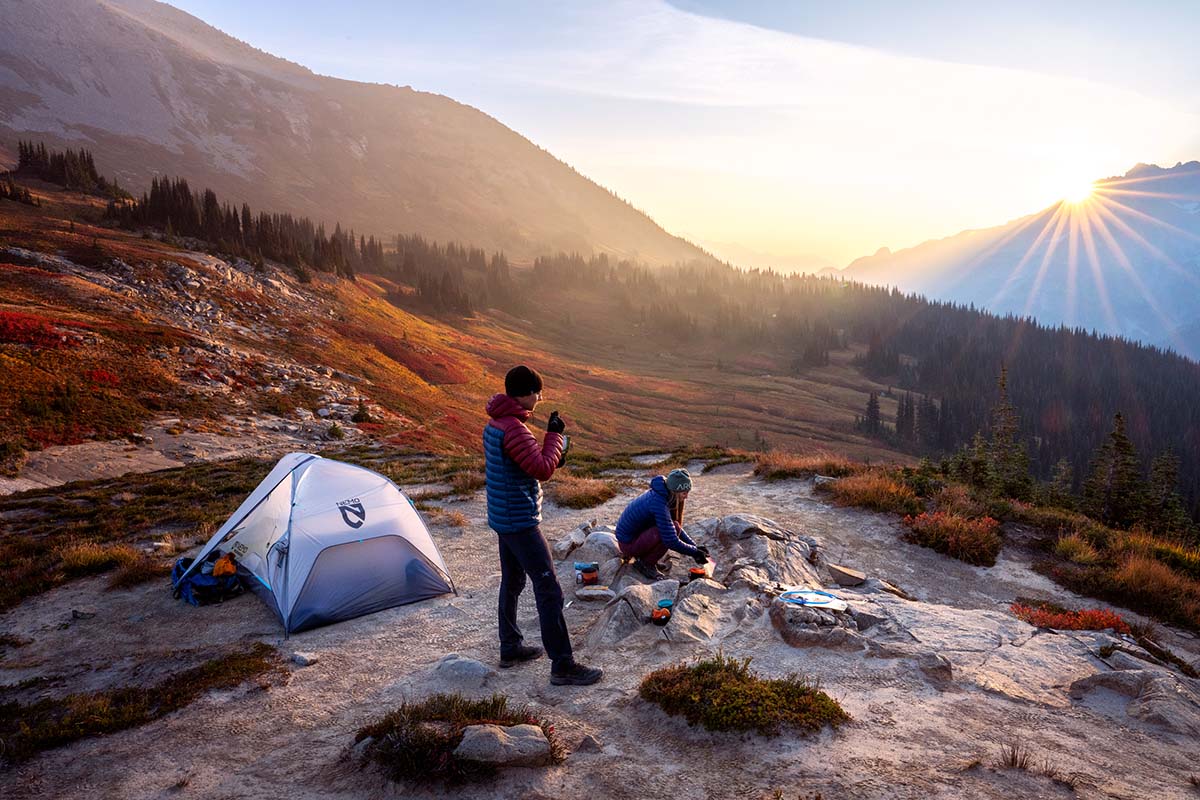
Non-Integrated Stoves
On the other hand, a non-integrated stove functions as two separate units: The fuel source and stove are at the bottom and a pot or frying pan is then perched on top. These stoves don’t include the heat exchanger of an all-in-one system and are generally less stable and less efficient. Further, the flame is more exposed to the wind, so it’s a good idea to use a windscreen (like this one from MSR) in most cases to keep the stove functioning effectively (this is particularly true for fuel types like alcohol, wood, and tablets that don’t burn as hot). These setups also lack the convenience of the systems above, and you’ll need to purchase your cookset separately.
But non-integrated stoves are not without their benefits. Most notably, they offer a great deal of versatility. You can swap out your pot for one of a different size (or even a frying pan), simmer a meal over the flame, and use white gas for better functionality in the cold or at higher elevations. Additionally, non-integrated stoves are often lighter and more affordable than those of the integrated variety (provided you choose a lightweight cookset). We think of these stove systems as an excellent choice for backpackers who like to cook over the flame and don’t need a particularly windproof setup. Those of the ultralight persuasion can cut weight by combining a screw-on canister stove (like the Snow Peak LiteMax) or alternative-fuel stove with a lightweight pot.

Like most backpacking gear, weight is an important consideration when choosing a stove. Before we start in on the specifics, it’s important to note that weight is rather difficult to compare among backpacking stoves, as you need to consider your type of fuel and amount needed, in addition to whether or not you’ll be adding the weight of a cookset. For each stove on our list, we’ve listed the bare bones weight, which does not include the isobutane/propane canister or liquid-fuel bottle, fuel pump (if required), or additional pots. Another exception are integrated systems like the MSR WindBurner, which factors its pot into the weight.

In general, you can expect alternative-fuel stoves to be the lightest options, and liquid-fuel stoves to be the heaviest. Canister stoves—especially non-integrated canisters models like the 2-ounce Snow Peak LiteMax—are truly a happy medium in terms of weight. In choosing the right system for you, it comes down to priorities: You’ll nearly always be sacrificing something—convenience, speed, durability, cold-weather performance, etc.—when you shave ounces. That said, every model here on our list is what we consider light and packable enough for backpacking. Even a relatively heavy design like the 1-pound-1-ounce MSR Reactor 1.7L is still reasonable and well worth its weight at high elevations or in the extreme cold.
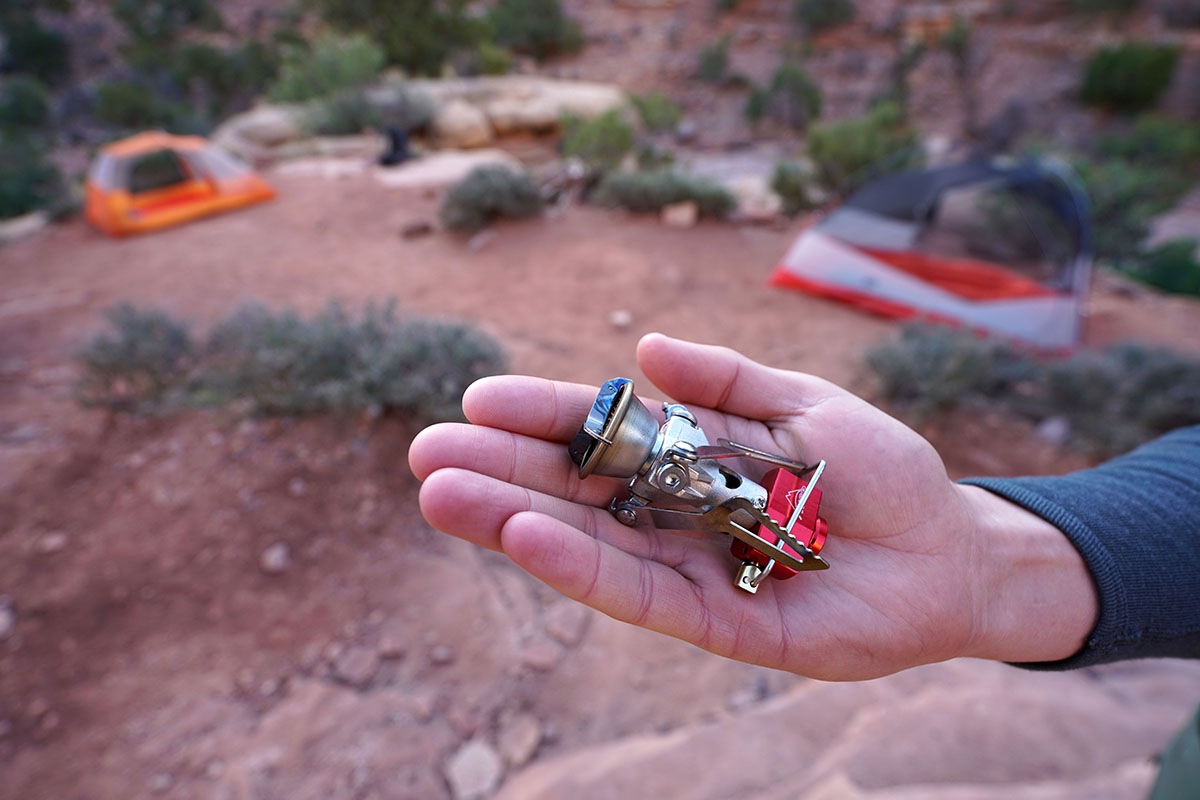
From a quick glance at our table above, you’ll see that boil times vary dramatically between models, ranging from around 2-3 minutes per liter of water to 10+ for wood-burning and alcohol stoves. In general, the numbers correlate very closely with the type of fuel: As we mentioned, integrated canister stoves are very efficient heaters with their all-in-one designs, while non-integrated canister models leave more of the flame exposed but still typically hover in the 3- to 5-minute range. Multi-fuel options like the MSR WhisperLite Universal and XGK EX are also pretty efficient, although boil time varies depending on which type of fuel you’re using (for example, kerosene takes considerably longer to boil than white gas). And at the extremely slow end of the spectrum are designs like the wood-burning Solo Stove Lite, Solo Stove Alcohol Burner, and Esbit Pocket Stove tablets.
All that said, these times were measured in laboratory settings with no wind or adverse conditions, both of which can significantly impact boiling speed. In other words, while the MSR WindBurner has a fairly middling advertised boil time of 4.5 minutes, it may beat the Jetboil Flash—which boasts a boil time of around 3.5 minutes per liter but has more of the stove exposed—in blustery weather. And again, at high altitudes or in extreme cold, propane/isobutane canisters can stop working entirely. Other factors to consider are pot support height, the amount of flame protection, windscreen coverage, etc. In the end, it’s important to consider your objectives and what kind of performance you need. If you backpack exclusively in fair weather, a non-integrated canister stove or alternative-fuel option is a viable choice. If you get out year-round and especially at altitude, a remote canister stove (especially a multi-fuel option) will be more reliable, regardless of the advertised times.
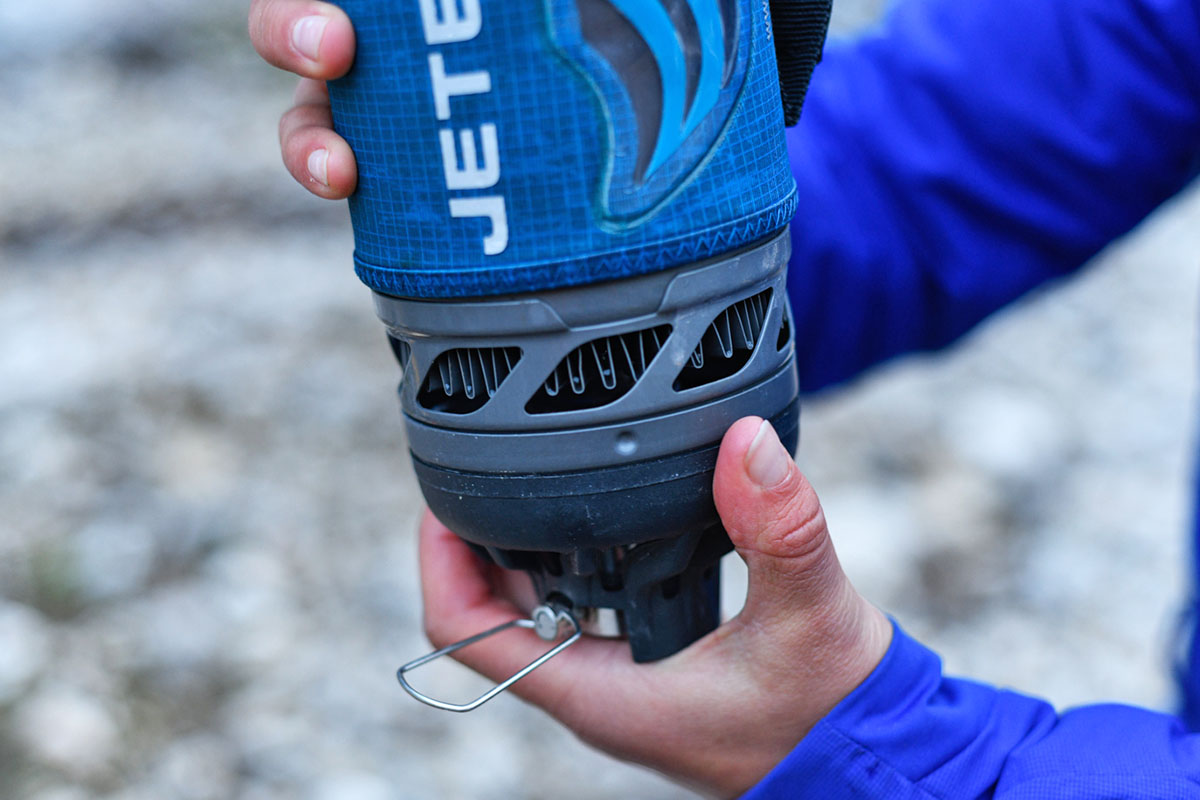
Finally, it’s important to point out that performance isn’t solely dependent on how fast your stove is able to boil water, but also how much fuel it takes to do so. For most backpackers, boil time and efficiency are equally important considerations. After all, if your stove can boil water in 2 minutes but blows through an entire canister very quickly, it’s not all that impressive. Thru-hikers in particular can save considerable weight by carrying less fuel, so efficiency can majorly impact a final decision. In general, manufacturers publish this number alongside boil times (often referred to as burn time), which indicates how long the stove will go through a given amount of fuel. But again, remember that these tests were done in a lab and will likely vary in the field. For a more in-depth breakdown, MSR has an excellent article on boil times and stove performance here.
BTUs, or British Thermal Units, measure heat output and help indicate how powerful a stove is. More specifically, it’s the amount of energy required to heat 1 pound of water by 1 degree Fahrenheit. To be clear, this isn’t the sole indicator of power (factors like burner size can also have an impact), but it a helpful spec in comparing models. In general, more BTUs will produce a stronger flame, which will allow you to cook more food faster. For example, the difference between MSR’s Reactor (9,000 BTUs) and WindBurner (7,000 BTUs) will be noticeable (as we mentioned, the Reactor is a great option for melting large amounts of snow quickly). On the flip side, that extra output comes with greater fuel consumption, meaning that the Reactor will burn through fuel quicker than the WindBurner. Most stove manufacturers publish BTUs alongside boil time, weight, and other specifications, but again, this number is just one part of the performance equation.

Those who plan to do more than just boil water will want a stove with quality flame control. Most canister and liquid fuel models have a twist valve to adjust the height of the flame, but a built-in regulator or advanced valve system is what truly improves a stove’s ability to simmer. Some stoves that simmer well include MSR’s WhisperLite Universal and PocketRocket 2, as well as the Jetboil MiniMo. On the other hand, basic liquid-fuel stoves (like the standard WhisperLite) and all-in-one systems like the Jetboil Flash typically don’t have the ability to run smoothly at low heat, although you can usually keep a small flame going with skillful regulation of the fuel valve (i.e., a whole lot of babysitting).
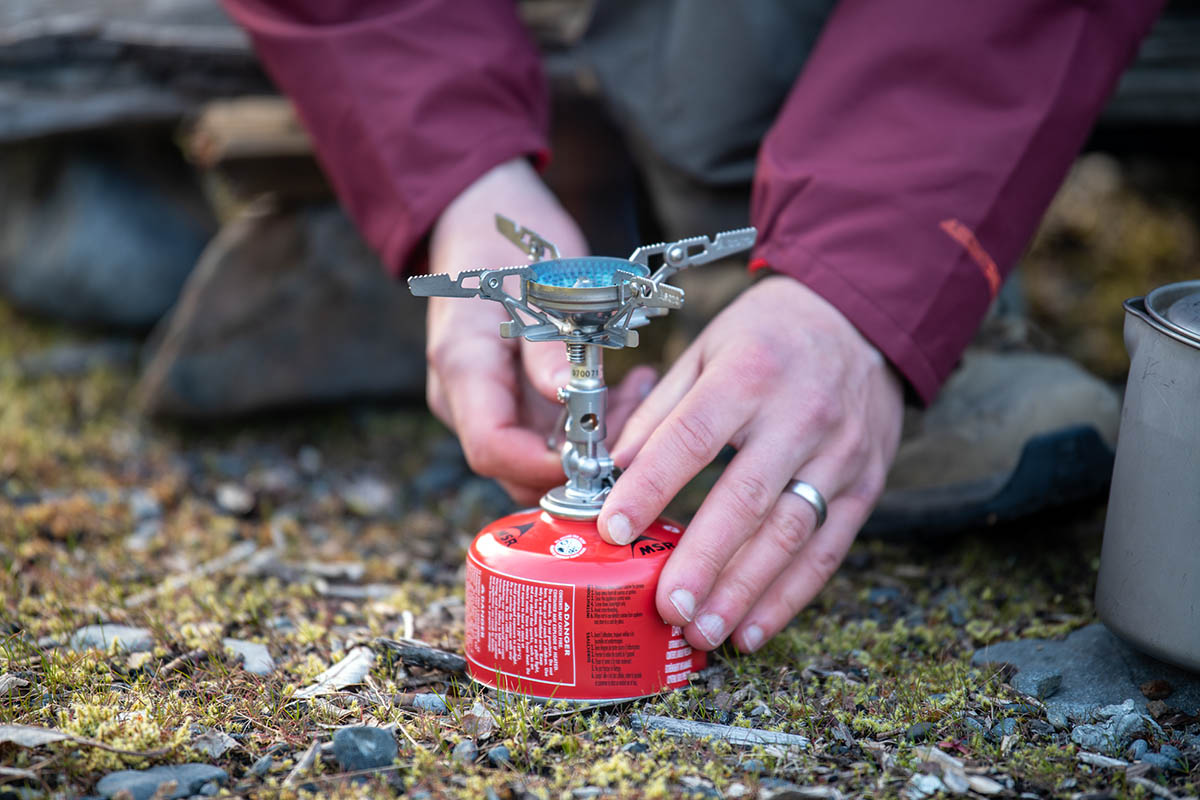
As we’ve touched on throughout this article, backpacking stoves and wind don’t get along. Strong winds can quickly put out your flame, and re-igniting your stove can be a major hassle in gusty conditions. For the best performance in blustery weather, all-in-one systems are far and away the best choice. The MSR WindBurner, for example, leaves very little of the stove exposed to the elements. Non-integrated stoves, on the other hand, typically will require the purchase of a separate windscreen or setup in a well-protected area at camp. Alcohol and wood-burning stoves fall at the bottom of the pack in terms of wind resistance, and it might take some practice and patience to get an even and consistent flame. If you backpack in consistently windy conditions—think above-treeline locations like 14ers in Colorado or the High Sierra—consider whether or not you need added protection before heading out.
If you have a screw-on or other detached stove and want to invest in a windscreen, we love this MSR model. At $20 and 2 ounces all in (to make it even lighter, we leave the bottom portion behind and only bring the wraparound sleeve), this simple piece of lightweight aluminum protects your otherwise exposed flame from the wind. In practice, the metal reflects heat to help warm your pot quicker, and less wind keeps the flame centered under the pot for better efficiency. The metal is thin and malleable so that it’s easy to get into place, and we think it’s worth carrying even when backpacking in moderate wind.
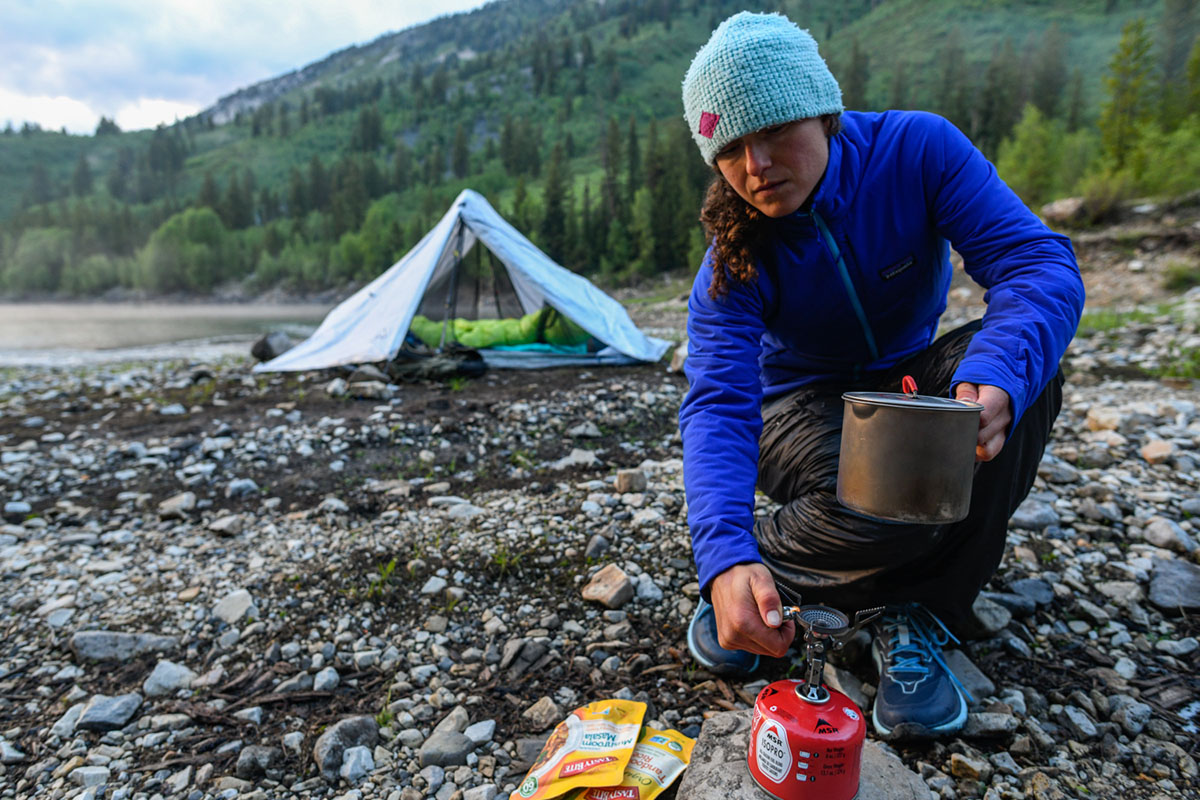
Interestingly, fuel reacts similarly to both cold weather and high altitude. For traveling in these conditions, we strongly recommend a liquid-fuel stove. White gas and other liquid fuels operate better in the cold, and you can regulate the dropping pressure with the fuel pump. Conversely, canisters often depressurize in the cold or at elevation, and freezing temperatures can keep the gas from moving from the canister to the stove. If you want to stick with a canister stove, you can hedge your bets with a remote design like the MSR WhisperLite Universal, which allows you to invert the canister for better fuel flow to the stove. If you don't have a remote design, you can tack on an adapter (like the MSR LowDown Remote Stove Adapter)—or opt for a 16-ounce canister (rather than smaller 8- or 3.9-oz. varieties) and keep your fuel warm by wrapping it in a layer during use.

Even with a liquid-fuel stove, there’s not much you can do to speed up cook times at high altitudes. Here, you’re dealing with two contributing factors: First, water evaporates faster at higher elevations, and second, water has a lower boiling point. This means that you’ll need to boil more water, and—importantly for dehydrated food eaters—your meals will take longer to cook because of the lower water temperature. In general, you’ll start to notice this slowing down around 5,000 feet, with the boiling point dropping roughly 5 degrees Fahrenheit every 2,500 feet.
You’ll often see canister-style stoves with a built-in starter, referred to as a push-button or Piezo igniter. With a simple push of a button (after loosening the fuel control valve), an electric spark lights your stove. This handy tool does add a tiny bit of weight and can have a small impact on a stove’s packed size, but the convenience factor is significant for some backpackers.
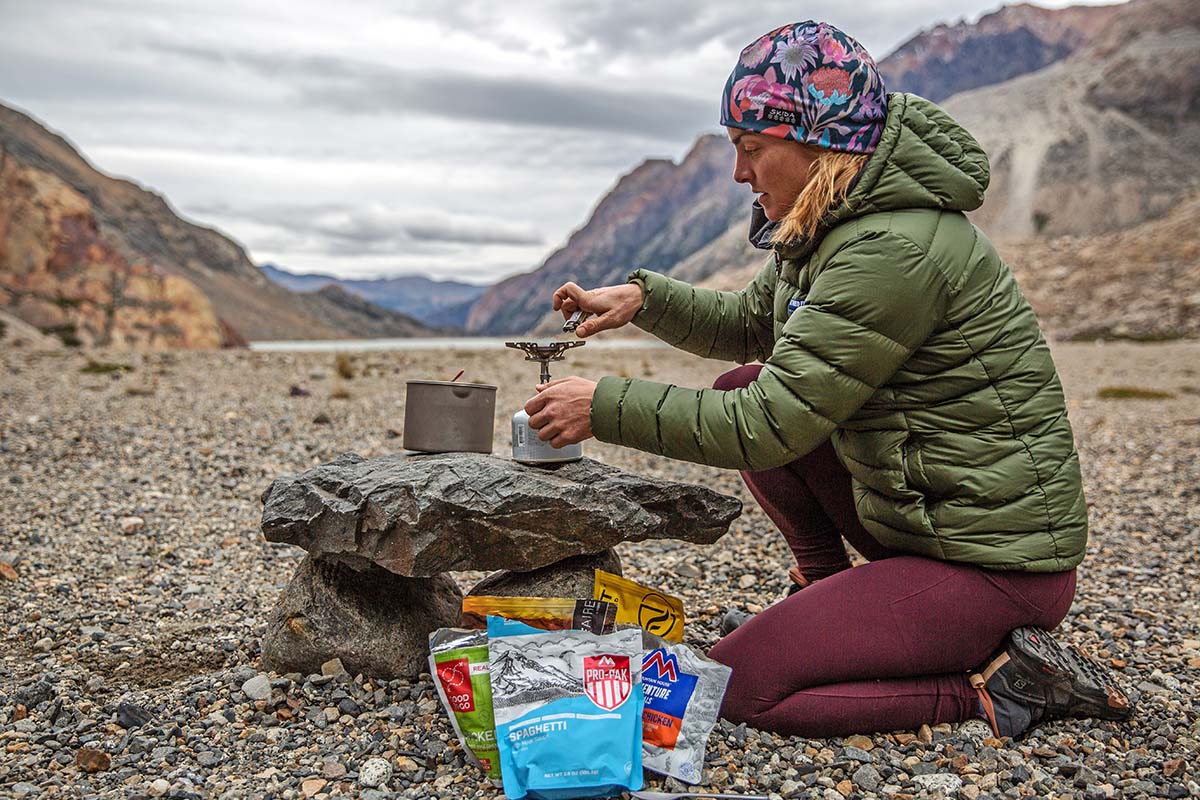
What are the pros and cons of a built-in igniter? Piezo lighters save time and are particularly helpful in windy conditions when a match could easily be blown out. On the downside, if they do fail (and many have been known to stop working over time), you have a useless protrusion stuck to the side of your otherwise fully functioning stove. Should this happen, however, you can continue to light the stove the old-fashioned way. No matter what, we always suggest bringing some backup matches or a lighter for the just-in-case.
One of the primary downsides to canister stoves are the canisters themselves—they don’t refill easily like liquid-gas canisters do, and they’re not super convenient to recycle. However, both of these challenges can be solved. The first thing to note is that affordable fuel-transfer devices exist. The FlipFuel, for example, allows you to consolidate half-used canisters for just $35 and a couple ounces. This is a really helpful tool especially for backcountry-goers, who would much rather carry one full canister rather than two half-full canisters. FlipFuel is the most common name-brand device, but cheaper varieties can also be found through retailers like Amazon.
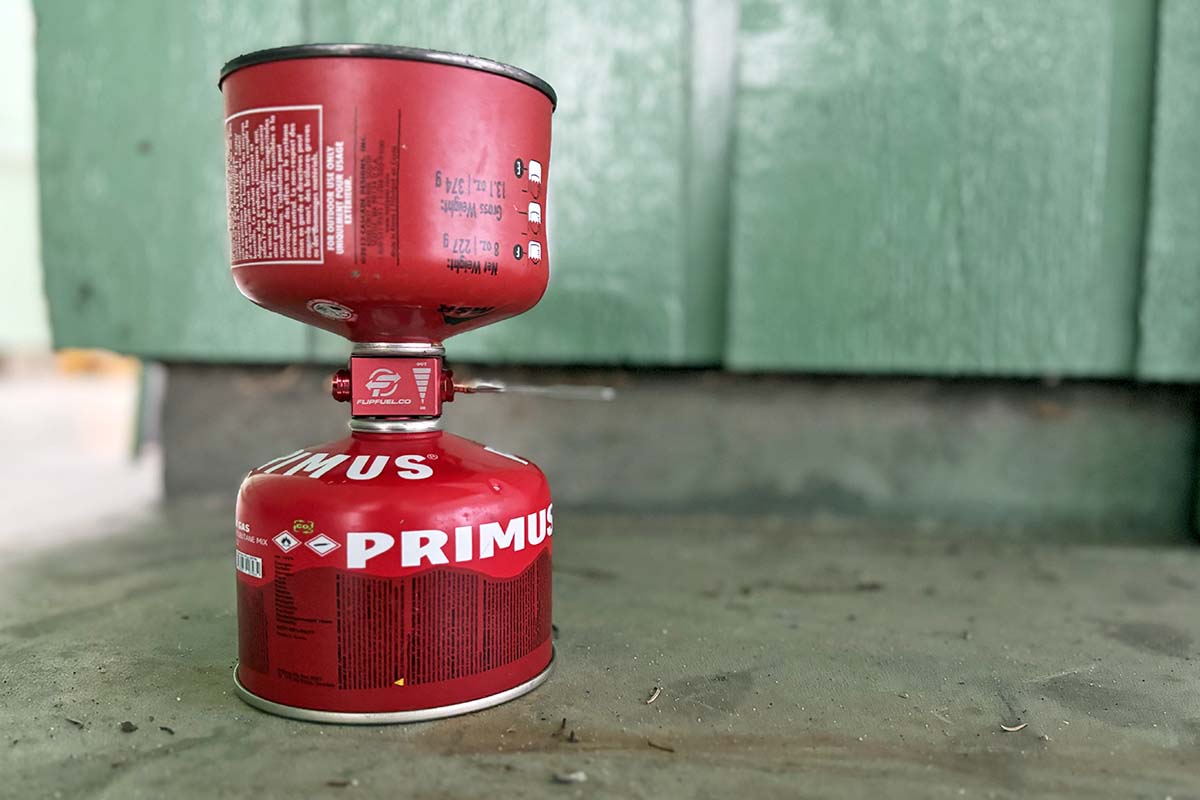
Even if you’ve consolidated your fuel canisters, you’ll still have the issue of how to dispose of the empties. MSR has a thorough article on this topic, but the long and short is that they can be recycled. You’ll want to make sure you empty your canister all the way, and then puncture it with a screwdriver, ice axe, or similar tool (to meet recycling requirements). Then, take it to a local recycling center that accepts mixed metals—most curbside bin services do not. It’s worth checking with your local gear shop too—the gear consignment shop in our small community has a drop-off bin for empty canisters.
A stove is just one part of your backcountry cookset, and unless you get an all-in-one design like the Jetboil models above or MSR WindBurner, you’ll likely need to purchase a pot separately. Stainless steel, aluminum, and titanium are the three most common materials in camping cookware. Stainless steel pots are the most affordable and durable—a great choice for heavy use—but they’re fairly hefty and don’t conduct heat particularly well (leading to hot spots where the pot is closest to the burner). Titanium is incredibly lightweight and decently strong, but like steel it’s not a great conductor (we recommend it for ultralight-minded hikers who predominantly use their stove to boil water). Finally, hard-anodized aluminum is perhaps the most well-rounded choice for most users: It conducts heat well, is relatively lightweight, and won’t cost you an arm and a leg. What’s more, hard-anodized aluminum pots generally come with a non-stick finish, making them the best bet for those who plan to cook over a flame.

Two of our favorites pots are the aluminum GSI Outdoors Halulite Boiler Pot ($40 and 8.6 oz.) and MSR’s titanium Titan Kettle ($65 and 4.4 oz.). If you want a full-on luxury setup, GSI’s Bugaboo Base Camper Cookset includes 2- and 3-liter pots and an 8-inch frying pan (in the medium size). Another option is purchasing pre-packaged cooksets like the Soto Amicus Stove and Cookset combo ($50) or MSR PocketRocket 2 Mini Stove Kit ($105), which are a convenient option for those just getting started and come with the benefit of a nesting design (you can fit the stove and small isobutane/propane canister in the pot for easy packing). But if your main goal is cutting weight, a canister stove like the PocketRocket or alternative-fuel option and titanium pot may be the best way to go.
In addition to a pot, there are a few other components to think about. One is cutlery, with options ranging from a set with a spoon, fork, and knife to a lightweight spork like the Humangear GoBites Uno (0.5 oz.) that gets the job done for pretty much any meal. There are also a wide range of plates and bowl options, ranging from titanium to aluminum, silicone, and more. A choice here will ultimately come down to preferences on weight, packability, and price. Finally, there are a number of add-ons like coffee presses, tea filters, and other accessories for backpackers who like to enjoy a beverage with breakfast. We’ve used the WindBurner Coffee Press with our stove for years and like how well it integrates with the rest of the system.

Whether it’s backpacking across Europe or cycling through South America, a reliable stove that can run on fuel that’s readily available locally is an absolute must. White gas and isobutane/propane canisters are not sold everywhere, but multi-fuel stoves can run on almost every type of fuel you might find throughout the world, including kerosene and unleaded gasoline. Our favorites include a few proven options from MSR: the WhisperLite International and Universal, and the XGK EX.
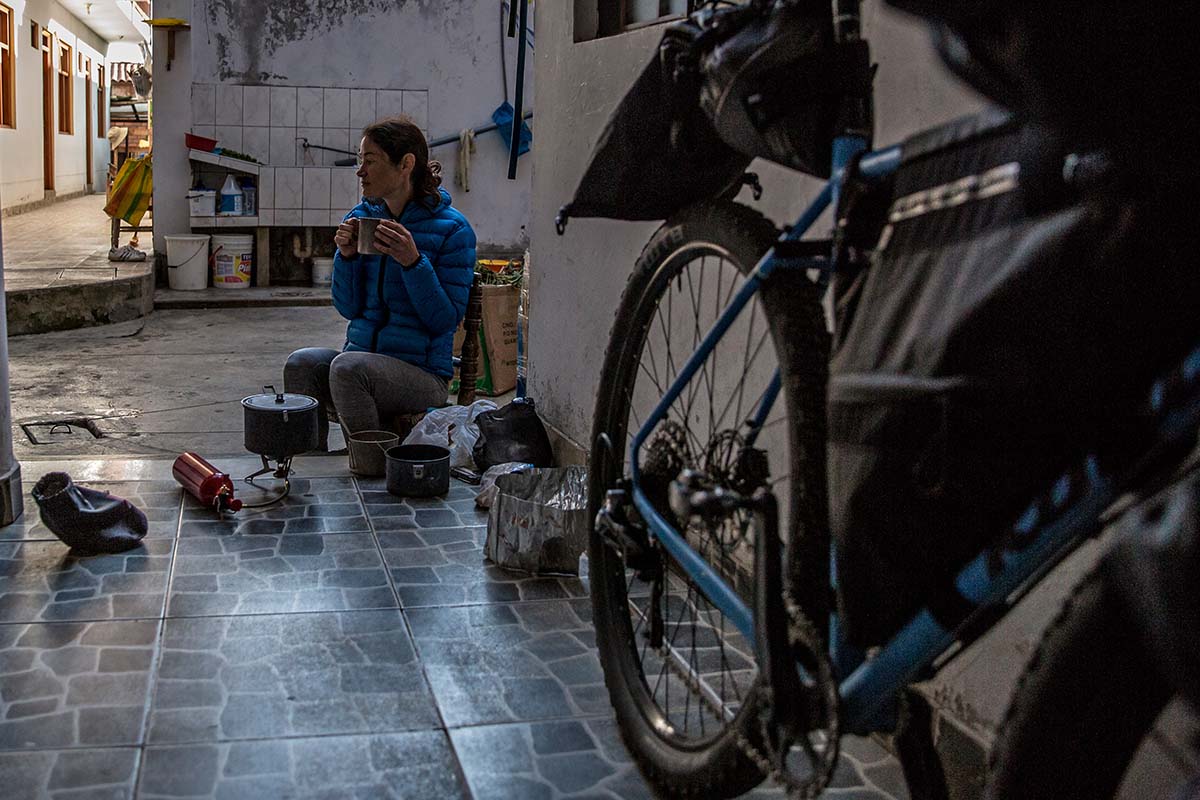
It’s always a good idea to research what types of fuel are most common at your destination. Due to airline restrictions, you cannot carry any fuel on the plane with you, whether in your checked bags or your carry-ons. Some travelers have even run into issues with dirty or used fuel lines creating some security delays at the airport. It’s our recommendation when researching to dig a little deeper than a basic guidebook. Don’t be satisfied knowing that the destination country has the fuel available, but get to know (as best you can) how readily available it is and how often can you refill during your travels. And as a final recommendation, make sure to be familiar with the quirks of your stove before heading out. Unleaded fuel will burn a lot dirtier than white gas or a canister, so make sure you’re savvy in how to quickly clean the fuel lines.
Back to Our Top Backpacking Stove Picks Back to Our Backpacking Stove Comparison Table